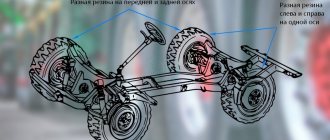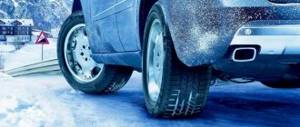Content:
- Differences between winter tires and summer tires
- What can be the consequences of using winter tires in summer?
- Traffic regulations
- Fines for driving a car on winter tires in summer
- When is the right time to change your winter tires to summer tires?
- Conclusion
With the establishment of warm weather in the regions, many drivers are faced with a number of difficult questions: is the air warm enough to change winter tires to summer ones, will there still be evening and morning frosts, have the queues at tire shops subsided? Such a keen interest in changing climatic conditions is very understandable: with the onset of a thaw, it is important to promptly change your car to tires for the season. The comfort and safety of driving depends on this. However, there are also those drivers who believe that friction Velcro and tires for mild European winters are quite suitable for use on summer roads. Is this so, and how dangerous is untimely replacement of tires, and what are the consequences of using tires out of season? You will find answers to these and other questions in this article.
Will the car pass?
To purchase an MTPL policy, for driving without which liability is provided for in Part 2 of Art. 12.37. Code of Administrative Offenses (traffic police fine 800 rubles), you must first issue a diagnostic card, that is, undergo a technical inspection.
The DC will not be issued if:
- non-compliance of the tread pattern height with the requirements established in clause 5.6. Appendix 8 to the Technical Regulations;
- installation of different tires on one axle;
- there is a section of the treadmill where the tread pattern height is below the minimum set value.
A motorist who arrives at a service station in the hot season with out-of-season tires will be able to undergo a technical inspection provided that the tire meets other established safety requirements.
Differences between winter tires and summer tires
Before answering the question of whether it is possible to drive on winter tires in the summer, it is worth taking a closer look at the characteristic differences between seasonal tires and the features of their operation. The difference between tires for a particular season lies in the tread pattern, compound composition and production technology. Summer tires and those used for winter always differ in the degree of hardness and level of adhesion to different types of road surfaces. This is due to the peculiarities of their operation. For example, summer tires for a car must withstand high temperatures and cope with braking on dry asphalt. The main elements of winter tires are considered to be dirt, snow and ice, where they should exhibit better grip and at the same time not become stiff in the cold. All-season tires stand out, which are suitable for use in regions with mild winters and not very hot summers. These tires act as a kind of intermediate option between summer and winter tires, but like any universal solution, they have a number of serious drawbacks. All-season tires don't handle hot temperatures as well as summer tires and don't brake as effectively on snow and ice as those designed specifically for winter.
Special markings will help you understand that you have winter tires. These tires are labeled "M+S" (or "M&S"), which indicates that they can be used for driving in snow and mud. The same markings are also on all-season tires, but they do not have one more element - a pictogram in the form of a snowflake against the backdrop of the Three Mountains. The latter indicates that the tires are suitable for use in cold, harsh winter conditions.
Differences between summer and winter tire compounds
In the production of seasonal tires, different rubber compounds are used. The composition of summer tires includes those particles that allow them to maintain characteristics when operating in positive temperatures up to +50-55 degrees. Winter tires have a different compound. It is designed for use in a separate climate zone with air temperatures in the range of +5-0 degrees and up to -45 degrees.
Differences between the tread patterns of summer and winter tires
In summer, cars travel mainly on good asphalt roads, which means they reach higher speeds. In this case, the tires must satisfy not only safety requirements, but also provide a comfortable ride, minimal fuel consumption, and good maneuverability. Winter tires face a slightly different task. These tires must cope with the rapid removal of water, slush from snow and mud, and brake well on slippery surfaces. For this reason, winter tires have a fairly deep tread with larger blocks and a more impressive number of sipes, which are often multidirectional. Additionally, metal spikes can be installed on such tires. They provide better grip on ice and packed snow. In summer, spikes are not only unnecessary, but also pose a danger to the driver. The use of studded tires also negatively affects the quality of the asphalt surface. For this reason, the tread of summer tires cannot be with spikes, and the blocks themselves are smaller in size, and the number of lamellas is significantly reduced.
Is riding Velcro dangerous in summer?
Many may wonder, what will happen if you drive on winter tires in the summer? In fact, this is very dangerous, since the first thing the driver will encounter is the instability of the car . Velcro begins to “float” on the road in hot weather. This situation can lead to an accident. In addition, the steering also leaves much to be desired. The car responds to driver commands with a delay.
But the shortcomings didn't end there. If someone decides to save on summer tires and drive in winter tires during the warm season, the savings will be very doubtful. Winter tires wear out faster in summer and fuel consumption increases by about 2 liters. This results in high fuel consumption and tire wear.
The last disadvantage is hydroplaning. If winter tires behave tolerably on dry asphalt, then when you hit a puddle, traction with the road disappears and aquaplaning occurs.
Based on the above, the conclusion suggests itself that using winter tires in summer is not the best idea. Some car owners do not change tires for the reason that they simply want to “finish off” them in the summer so that they can buy new ones next year. But again, this practice is very unsafe and the risks are too high.
Technical characteristics of such tires
Winter tires have some differences:
- It's softer. This feature provides better traction on the road in the winter on icy and snowy areas, but already on clean asphalt these characteristics are underestimated.
- Winter tires have a special composition that prevents them from becoming dull in the cold. Summer tires are stiffer and lose their elasticity at low temperatures.
- This is the drawing itself. With Velcro, it is made in the classic herringbone style, there are more cuts and they are deeper. Summer tires have a less intricate pattern.
What can the use of winter tires in summer lead to?
From year to year, there are those drivers who neglect logic and common sense and, in an attempt to save money, continue to drive winter tires in the summer. This often causes very disastrous consequences: from high levels of wear of expensive tires to the car getting into accidents of various sizes. So, let’s figure out why you can’t drive on winter tires with or without studs (Velcro) in the summer. Features of the compound and tire tread structure cause deterioration in the performance characteristics of winter tires when high temperatures occur. This causes the following negative consequences.
- Higher fuel consumption and tire noise.
- Less resistance to hydroplaning.
- Long braking distance on dry roads.
- Rapid tire wear.
- Excessive heat generation.
It is worth noting that winter tires are heavier than tires used in summer. This affects directional stability in different conditions and leads to increased fuel consumption. In addition to the practical side of the issue, do not forget about safety standards. Driving on winter tires in summer is dangerous, since the car handles worse on dry roads, may not be able to quickly remove the watery film from the tire contact patch and will have an increased braking distance.
How winter studded tires behave in summer
Winter studded tires on roads in the summer show even greater detrimental performance than friction tires.
In addition to all the indicated consequences that are observed with Velcro, studs additionally show such consequences as:
- loss of studs that fall out due to the destruction of rubber, their hooking into the asphalt, or the melting of rubber on summer asphalt. As a result, the winter studded tire is completely destroyed;
- destruction of the road surface;
- a strong increase in noise level on dry summer asphalt surfaces.
The spikes are displaced due to poor quality
. Important!
Driving on spikes in the summer is not just unacceptable, but catastrophic for the driver, tires, pedestrians and road surface.
What could be the consequences?
The main disastrous consequences of using winter tires in summer can be:
- Tires wear out very quickly due to the fact that the alloy of winter tires is much softer in structure. None of the manufacturers gives absolutely any guarantees for tires provided they are used at air temperatures above +7 degrees Celsius. In the summer, an extremely strong process of melting of tires is observed, the process of rolling resistance increases significantly, and as a result, a much greater process of heating the surface of the tire occurs. It is even possible for winter tires to be cut by small stones on the roads, which are completely harmless to summer tires. Excessive heat in hot conditions may even cause the tire to explode. If a tire fails while driving at high speed or while driving in heavy traffic, the consequences can become even more negative.
- Difficult steering is possible even at a fairly moderate temperature for summer of +11 degrees Celsius. The maneuverability of the car also decreases, it begins to wobble and accelerates poorly. Often tires can fail after 2-3 such trips.
- Increased braking distance. When driving a car with winter tires, the risk of long braking distances increases. Sometimes this distance reaches two lengths of the car body. The process of driving on winter tires in summer is dangerous in this case for both the driver and pedestrians.
- Fuel consumption increases significantly. For the necessary adhesion of the tire to the road surface, winter tires require a significantly greater amount of effort, which is provided by the engine, which consumes 5-10% more fuel.
Based on this, replacing car tires in accordance with the onset of the season is simply necessary. Using seasonal tires for other purposes simply leads to catastrophic consequences.
Traffic regulations
Lawmakers have repeatedly tried to introduce official restrictions against driving on winter tires in the summer. Relevant projects were submitted for discussion in 2009 and 2014. The first provided for a fine of 500 rubles for driving using studded winter tires on cars in the summer, the second implied a penalty of 2 thousand rubles. Both bills were rejected. The only requirement that remains relevant: when using studded tires, the driver must stick a special warning sign on the rear window of the car. However, if the current Russian legislation and traffic regulations do not directly prohibit driving in the summer on friction or European winter tires, then there are still restrictions for tires with studs. In the Technical Regulations of the Customs Union TR CU 018/2011, which was adopted in 2015, there is a special section in Appendix No. 8. Paragraph 5.5 states that in summer it is forbidden to drive on winter tires with studs, and in winter you cannot install summer tires on a car. It also says that the summer period is considered to be the months from June to August, and the winter period lasts from December to February. This Technical Regulation is valid throughout the Russian Federation, but in some regions the timing of the onset of winter and summer may shift depending on climatic conditions.
What's the fine?
Here's some good news! Despite the direct ban on driving a vehicle with winter tires in the summer, there is no penalty for this in 2021: no fine, no operating ban, no other sanctions from the Administrative Code.
If a traffic police officer tries to deceive you, demand that you indicate a specific article of the Code of Administrative Offenses. In any case, it is indicated in the resolution and protocol - this obligation is regulated by the Administrative Code. And the Code of Administrative Offenses has an article - 12.5, part 1, which provides for a fine of 500 rubles for driving under conditions under which such driving is prohibited.
But this article has a direct reference to traffic rules, and the latter do not contain any prohibition. We have already mentioned above that such a ban is contained in the Technical Regulations.
What can a fine be issued for?
But there are other requirements for tires - specifically even for winter tires, because at the moment you are using them. We described in detail how winter and summer tires formally differ in another article about summer tires in winter. In short, this is the marking of a snowflake on a mountain with three peaks or the meaning of “M+S”, “M&S”, “MS”.
This is what she looks like:
That is, even if the tires are even studded, but there is no indicated marking, then formally you are not violating anything.
So, all requirements for winter tires, for which a fine may be issued, are regulated by the Traffic Regulations, specifically, Section 5 of the Main Faults (Appendix to the Traffic Regulations). Let's list them:
- tread depth of at least 4 mm (and it doesn’t matter that you use winter tires in the summer, a smaller residual depth is prohibited specifically for tires labeled as winter tires); but the requirement is relevant only if there are no wear indicators on the tires. If so, then, according to these indicators;
- There is damage on the tires in the form of:
- cuts, peeling, tears, if the cord is visible (it does not matter whether the cord threads are broken or not),
- separation of the tread from the “side”;
- if the tires do not correspond to the vehicle speed or load index;
- on one axle (front or rear) there are different tires, except for new and used ones (if they are not retreaded tires);
- studded tires are installed at the same time as non-studded tires.
If you do not comply with the above requirements, then a fine of 500 rubles becomes legal.
Fines for driving a car on winter tires in summer
If the driver of the car violated the requirements of TR CU 018/2011 and continued to drive in the summer on winter tires, he can get off with a simple warning. However, traffic police officers may not only inquire about the tire markings, but also the remaining tread depth. According to current standards, it must be at least 4 mm for winter tires and at least 1.6 mm for those tires used in summer. If this requirement is violated, the driver of the car will be fined in the amount of 500 rubles (Part 1 of Article 12.5 of the Code of Administrative Offenses of the Russian Federation).
What is the braking distance?
According to road tests conducted by the German ADAC club, the braking distance of a car on winter tires at above-zero temperatures is 44% longer than on summer tires. The measurements were carried out at an asphalt temperature of 25 degrees, and the car was braked from a speed of 100 km/h. Thus, a car with an anti-lock braking system (ABS) in the “winter” rolled forward as much as 16 meters compared to the “summer”.
In general, as the temperature rises from +4 to +11 degrees, the braking distance of winter tires increases by half a meter with each increase in degree.
Therefore, in the spring, you shouldn’t delay changing your shoes, and in the fall, don’t rush to switch to “winter.”
Do I need to buy a winter spare tire or keep the summer one? More details
When is the best time to change winter tires to summer tires?
If you rely on the requirements of the Technical Regulations of the Customs Union, you need to install summer tires on your car before June. This can be done at the end of the winter period (from March, unless otherwise provided by regional standards and regulations). Auto experts recommend changing winter tires to summer tires when a thaw sets in, when the air warms up to +7 degrees during the day. In practice, in such weather, precipitation is still possible, especially at night. Winter tires will cope better with them, so you should install them on your car at a time when the air warms up to +10 degrees during the day.
The spikes fly out
Studded winter tires have a rigid frame into which metal spikes are inserted, and a soft tread with lamellas enveloping the road surface. Thanks to them, the tire seems to “stick” to the asphalt.
During the thaw, winter tires soften even more and lose their ability to resist stress. She floats on the asphalt like an eraser on paper. If you start to actively brake with a sharp push of the pedal to the floor, the tread rubs against the asphalt and loses the surface layer of rubber. The wheels leave a rough black mark on the road. Naturally, the braking distance increases and the car, when braking from 80 km/h, loses about 1.5 car lengths to itself, but on summer tires.
In addition, the spikes also receive damage. They are designed to tuck into their sockets on hard surfaces to avoid handling problems. However, on warm asphalt, the hardness of the retaining layer decreases. The spikes cling to the asphalt with the tips of the bumps and are torn out by the roots when braking. This happens especially often at noon in clear weather. Such a spike flies back and can damage passing cars. Chips remain on the paintwork, and cavities form on the windshield at the point of impact.
Question answer
When will tires appear that cannot be flat?
How to drive in warm weather on winter wheels?
However, it is still possible to drive on winter tires if you are careful and keep your distance. To compensate for the increase in braking distance, you need to add an additional 16-20 m to the normal distance to the vehicle in front in order to have space for a smooth reduction in speed.
In addition, you will need to give up a sporty driving style with sharp acceleration and braking in order to preserve the tread of winter wheels. If these simple rules are followed, softer winter wheels will provide even greater comfort when driving on poor roads riddled with potholes. They will absorb strong impacts and help protect the suspension.











